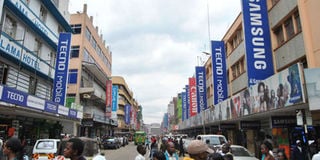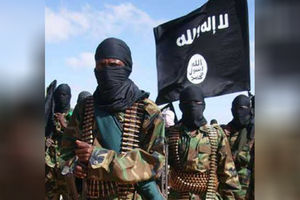Nairobi City street names with a legacy

Electronics shop along busy Nairobi's Luthuli Avenue on June 30 2012. PHOTO | ANTHONY OMUYA | NATION MEDIA GROUP
What you need to know:
- They include, among others, Ralph Bunche, Tubman, Du Bois, George Padmore, Luthuli, Muindi Mbingu and Wabera.
- Muindi Mbingu street is named after a fiery Kamba leader and ex-colonial policeman, Samuel Mundi Mbingu.
- Wabera Street is named after first African District Commissioner (DC) for then Isiolo district, the late Daudi Wabera.
Watching on TV this year’s Labour Day celebrations, my nine-year-old son – most likely bored by Francis Atwoli’s verbal theatrics and wishing I left him to switch on to his favourite cartoon channel — had ambushed me with the question: “Dad, Uhuru Kenyatta owns Uhuru Park and Uhuru Highway?” “Why?” I asked. “Because they’re named after him”, he replied.
First I had to explain to him that public facilities are named after individuals to honour them, but not as an indication of ownership.
Second, I had to inform him that in this particular case the park and the highway aren’t named after the President, but were called so to commemorate the event of Kenya attaining uhuru, the Kiswahili word for independence. On the other hand, the President was named Uhuru – his family lineage name is Muigai – to celebrate his father, Mzee Jomo Kenyatta’s, freedom (also uhuru in Kiswahili) from colonial prison.
The elder Kenyatta was set free on August 14, 1961, and President Uhuru born about two months later on October 26.
My son’s query on names of public utilities in the city sent me down memory lane to remember one of the first stories I did as a youthful journalist in the 1990s.
MUINDI MBINGU
This is how it came about: One day my boss, then Kenya Times newspaper Features Editor David Kioko, overheard me directing a friend on the phone how to get to our offices at Kingsway House on Muindi Mbingu Street. When I put the phone down, he ambushed me with the question: “Young man, do you know who Muindi Mbingu was?” At the time I didn’t know and told him as much to which he said: “Now I have caught you, your next assignment is a story on who is named after which avenue, main road, and popular lane in Nairobi.”
Today, I bring you updated excerpts from the story I did at the time. I start with Muindi Mbingu which is the street that gave birth to the story.
The street is named after a fiery Kamba leader and ex-colonial policeman, Samuel Mundi Mbingu. This is how he rose to prominence and why he came to be immortalised in the capital city.
In 1938, the colonial government ordered the Kamba people to reduce sizes of their cattle stocks by compulsorily selling their animals to the Athi River-based Kenya Meat Commission (KMC) which had just been built.
Muindi Mbingu organised his community to defy the order. He went further to mobilise over 3,000 protesters to walk to Nairobi and demand audience with the colonial Governor.
On arrival at the capital, they were told they couldn’t see the Governor who was playing polo at the Ngong’ Race Course.
DENIED ACCESS
They followed him there and, when denied access, the protesters said they would camp on Ngong’ Road until the de-stocking order was lifted. It was, but the colonialists punished Muindi Mbingu by arresting and detaining him in the faraway Lamu islands.
The road next to the University of Nairobi and the Central Police Station is named after pioneer freedom fighter and founder of the Kikuyu Central Association (KCA) whose roots gave birth to the Kenya African Union (KAU), and later the party of independence, Kanu.
On his arrest by colonialists in 1922, Africans in Nairobi led by the heroine, Ms Muthoni Nyanjiru, stormed Central police station where he was locked. White settlers who had been drinking beer at the nearby Norfolk Hotel responded by opening fire, killing on the spot 22 of the demonstrators.
ARGWINGS KODHEK
The road in Hurlingham is named after the then Minister of Foreign Affairs who died on the road driving to his home on January 29, 1969.
He had a colourful history as the first Kenyan to graduate with a law degree in 1951 and the first to be admitted to the London Bar.
On return to colonial Kenya, a white-owned law firm offered him a job at a third the salary paid to whites.
He declined, briefly took up a job with an Asian law firm, but quit to found the first African-owned legal practice in the country which dwelt mainly on giving pro-bono (free) legal services to arrested Mau Mau fighters. Once, the colonial Governor Evelyn Baring taunted Kodhek that the initials, “CMG”, in his name stood for “Commander of Monkeys and Goats”.
The latter hit back in a Shakespearean mock wit: “Woe and wilt Britania that she chooses to export the most stupid and vile of her sons to civilise Africans. Oh mistaken Queen, come and evict these simpletons who understand nothing of their idiocy and insults your royal foolishness!”
The street is named after first African District Commissioner (DC) for then Isiolo district, the late Daudi Wabera. He was killed in action fighting the Shifta war where a section of Somalis in the then Northern Frontier District (NFD) demanded secession of half the Kenyan landmass to Somalia. His death led to escalation into full-scale war which vanquished the secession bandits.
LUTHULI AVENUE
South Africa’s Albert Luthuli was among the early pioneers of the country’s ruling party, the African National Congress (ANC). He had joined the party in the 1940s to lead the freedom fight, first as secretary-general, and later the party president. He mentored the second generation of his country freedom fighters who included the legendary Nelson Mandela, Govan Mbeki (father of former President Thambo Mbeki), Oliver Tambo, Walter Sisulu, and Robert Sobukwe. He would be the first black on the African soil to bag the Nobel Peace prize in 1961.
RALPH BUNCHE ROAD
The road in Nairobi’s Community area is named after the African-American academic, freedom fighter, and diplomat Ralph Bunche. He’d preceded Albert Luthuli as the first black to win the Nobel Peace prize in 1950. He had visited Kenya in 1938 at the invitation of Kikuyu elders who had rebelled against white missionaries and established their own independent churches and schools. Ralph Bunche gave a powerful Obama-style speech titled: “Returning to the land of my ancestors”. The speech so annoyed the colonialist but got a wide applause from the Africans who gave him a local name “Kariuki”, meaning one who had risen from the dead.
TUBMAN ROAD
The road in the CBD is named after the 19th President of Liberia, William Tubman, who died in 1971. He is credited for the creation of modern-day Liberia, the home of majority descendants of African slaves shipped back from America. He wears another hat as one of the pioneer founders of the Organisation of African Unity (OAU), the precursor to the African Union (AU). He had good rapport with President Jomo Kenyatta especially on account of their firm stand that newly independent countries steer clear of communism. By coincidence, Tubman’s nephew, Mr Victor Pratt, would years later befriend President Kenyatta’s daughter, Ms Christine Wambui, when they met while on studies in the US. They ended up husband and wife a year after Mzee Kenyatta’s death.
GEORGE PADMORE LANE
The lane off Ngong’ Road is named after the Jamaican-born, famous for the founding of the pre-independence pan-African movement in the 1940s, that championed the cause of liberation of Africa. Mzee Kenyatta had met him when both lived in London in the late 1930s, and they became great friends and comrades in the struggle. Padmore had such great influence on youthful Kenyatta that he momentarily converted the later to a communist, even organising for the later’s lengthy stay in Moscow. Those were the late Kenyatta’s most revolutionary days, which easily come out in the fiery language in articles he wrote for left-leaning newspapers in London. In one the articles he said: “With support of all revolutionary workers and peasants, we must redouble our efforts to break the barriers that separate us. We must refuse to give any support to the British imperialists either by paying taxes or obeying any of their slave laws!” The burning spear of Kenya was breathing fire and brimstone.
MARCUS GARVEY ROAD
The road off Valley Road is named after another Jamaican-born pan-Africanist Kenyatta met and befriended in London. Cash-strapped and without an office when he lived in London, the Kenyan leader had found “office’ in a small hotel operated by Marcus Garvey’s wife downtown. Marcus Garvey is the founder of the culture of defiance that came to be known as Garveyism, whose offshoots were the “Nation of Islam” crusade of 1960s, and later the Rastafarian culture.
DU BOIS LANE
W.E.B Du Bois is yet another pioneer pan-Africanist who had great influence on Kenyatta in London, hence the name of the lane in River Road.
GROGAN/RIVER ROAD
Grogan, now Kirinyaga Road, is the name of a notorious early British settler and later member of colonial parliament, Colonel Ewart Grogan, notorious for publicly flogging Africans in the middle of the capital city. He was a deranged man who at the age of 24 walked from Cape Town to Cairo, taking two and half months, just to impress step-father of the girl he wanted to marry, one Gertrude Edith. When his future wife died of heart-attack in 1947, he donated the land on which Gertrude’s Children’s Hospital in Muthaiga is built and still carries her name.




